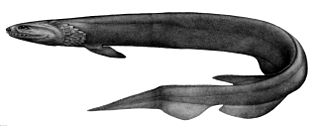
The frilled shark, also known as the lizard shark, is one of the two extant species of shark in the family Chlamydoselachidae. The frilled shark is considered a living fossil, because of its primitive, anguilliform (eel-like) physical traits, such as a dark-brown color, amphistyly, and a 2.0 m (6.6 ft)–long body, which has dorsal, pelvic, and anal fins located towards the tail. The common name, frilled shark, derives from the fringed appearance of the six pairs of gill slits at the shark's throat.

African elephants are members of the genus Loxodonta comprising two living elephant species, the African bush elephant and the smaller African forest elephant. Both are social herbivores with grey skin, but differ in the size and colour of their tusks and in the shape and size of their ears and skulls.
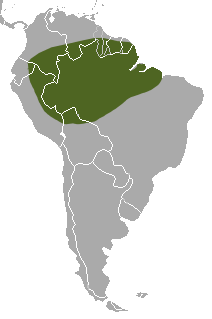
The Amazon weasel, also known as the tropical weasel, is a species of weasel native to South America. It was first identified from a museum specimen mislabelled as coming from Africa, hence the scientific name.
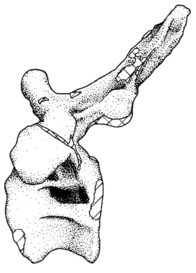
Tornieria is a genus of diplodocid sauropod dinosaur from the Late Jurassic in Lindi Region of Tanzania. It has a convoluted taxonomic history.

Kigelia is a genus of flowering plants in the family Bignoniaceae. The genus consists of only one species, Kigelia africana, which occurs throughout tropical Africa. The so-called sausage tree grows a poisonous fruit that is up to 60 cm long, weighs about 7 kg, and resembles a sausage in a casing.
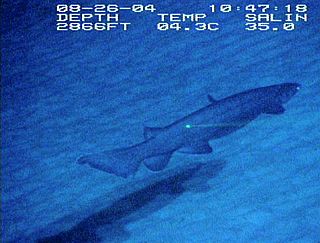
The southern African frilled shark is a species of shark in the family Chlamydoselachidae, described in 2009. It is found in the deep waters off southern Angola to southern Namibia. This species is difficult to distinguish from the better-known frilled shark, but is smaller at maturity and differs in several proportional measurements including head length and mouth width. It seems to be a specialized predator of smaller sharks, using its flexible jaws and numerous needle-like, recurved teeth to capture and swallow them whole. Reproduction is presumably aplacental viviparous, as with the other member of its family.

The African angelshark is an angelshark of the family Squatinidae.

Prunus africana, the African cherry, has a wide distribution in Africa, occurring in montane regions of central and southern Africa and on the islands of Bioko, São-Tomé, Grande Comore, and Madagascar. It can be found at 900–3,400 m (3,000–10,000 ft) above sea level. It is a canopy tree 30–40 m in height, and is the tallest member of Prunus. Large-diameter trees have impressive, spreading crowns. It requires a moist climate, 900–3,400 mm (35–130 in) annual rainfall, and is moderately frost-tolerant. P. africana appears to be a light-demanding, secondary-forest species.

The rufous-naped lark or rufous-naped bush lark is a widespread and conspicuous species of lark in the lightly wooded grasslands, open savannas and farmlands of the Afrotropics. Males attract attention to themselves by a bold and often repeated wing-fluttering display from a prominent perch, which is accompanied by a melodious and far-carrying whistled phrase. This rudimentary display has been proposed as the precursor to the wing-clapping displays of other bush lark species. They have consistently rufous outer wings and a short erectile crest, but the remaining plumage hues and markings are individually and geographically variable. It has a straight lower, and longish, curved upper mandible.

Afzelia africana, the African mahogany, afzelia, lenke, lengue, apa, or doussi, is a Myrmecophyte tree species in the family Fabaceae.

Turraeanthus africanus is a species of plant in the family Meliaceae, also known by the common names avodiré, apeya, engan, agbe, lusamba, wansenwa, African satinwood, and African white mahogany.

Burkea africana, the wild syringa, is a deciduous, medium-sized, spreading, flat-topped tree which grows in the woodlands and savannas of sub-Saharan Africa. It is the sole species in genus Burkea, which belongs to the subfamily Caesalpinioideae of the family Fabaceae.

Cherninia is an extinct genus of mastodonsaurid temnospondyl. The type species, Cherninia denwai, is known from the Denwa Formation of India. It is based on a massive skull, ISI A 54, which was originally considered a species of Parotosuchus in 1998 before being given its own genus in 2001.
Africana philosophy is the work of philosophers of African descent and others whose work deals with the subject matter of the African diaspora. The name does not refer to a particular philosophy, philosophical system, method, or tradition. Rather, Africana philosophy is a third-order, metaphilosophical, umbrella-concept used to bring organizing oversight to various efforts of philosophizing. Africana philosophy is a part of and developed within the field of Africana studies.
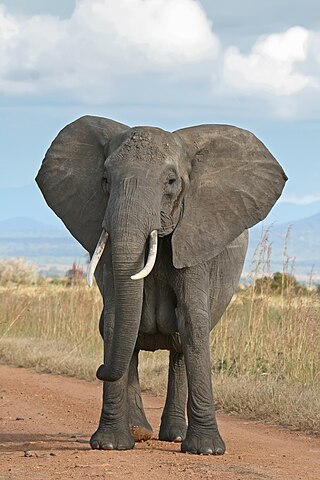
The African bush elephant, also known as the African savanna elephant, is one of two extant African elephant species and one of three extant elephant species. It is the largest living terrestrial animal, with bulls reaching an average shoulder height of 3.04–3.36 metres (10.0–11.0 ft) and a body mass of 5.2–6.9 tonnes (11,500–15,200 lb), with the largest recorded specimen having a shoulder height of 3.96 metres (13.0 ft) and a body mass of 10.4 tonnes (22,900 lb).

Treculia is a genus of trees in the plant family Moraceae that is native to west and central Africa and Madagascar. The best-known member of the genus, Treculia africana, commonly known as the African breadfruit, is used as a food plant.
Elysia rufescens is a species of sea slug, a marine gastropod mollusc in the family Plakobranchidae. This sea slug resembles a nudibranch but is not classified in that order of gastropods, instead belonging to a closely related clade, Sacoglossa, the "sap-sucking" sea slugs. This species was first described by Pease from Tahiti in 1871.

Bryopsis plumosa, sometimes known by the common names green algae or hen pen, is a type of green seaweed.















